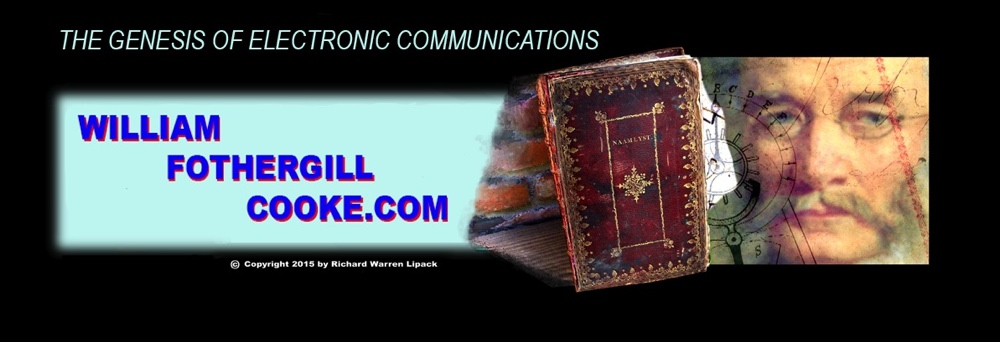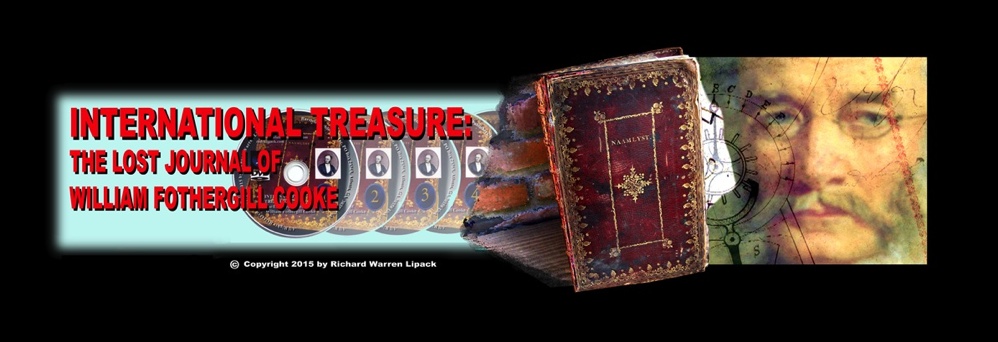

AMAZING DISCOVERY OF ELECTRIC DIGITAL COMMUNICATIONS ON EARTH - WM F COOKE JOURNAL - PART 2 OF 8
An important discovery important manuscript was made in the late 1990's by historian and antiques artifacts and manuscript dealer Richard Warren Lipack in Atlanta, Georgia, where he had moved down to from the north eastern part of the United States almost a decade before.
The manuscript book has been lost for almost two centuries. Although the signature immediately notcied in the manuscript was that of Charles Wheatstone, the Cooke signatures were not conclusive at first glance. There was only one example of Cooke's signature on the Internet, and few examples of his signatures are readily available - outside of that now housed at the New York City Public Library - locked away in a storage file that requires an appointment to view. That holdings consists of the vast majority of the extant Cooke letters in the world, having come from the collection of IEEE, who first received the collection as a donation back in 1901 from Schuyler Skatts Wheeler, an early force in electric motor manufacturing by the turn of the century.
At first it was thought that it was the work of Frederick Kerby, a machinist for Cooke and Wheatstone, the inventors of the first perfected commercial electric telegraph communications system in the world. The work found in Cooke's journal was executed between the years 1836 and 1842. The journal originated in England, yet was found in America. It had travelled one fifth of the world before it was discovered in the late 1990's. And then it took a decade before the journal was properly authenticated as to its true author: that of William Fothergill Cooke.
Richard Warren Lipack, the American based international historian, antique artifacts dealer and archivist discovered inventor Cooke's manuscript telegraph builder's journal in the late 1990's in America - thousands of miles from where it was created. It took approximately ten years to finally authenticate that the journal was indeed the the work of William Fothergill Cooke - who had worked between 1836 and late 1840 with Professor Charles Wheatstone of King's College, London - to perfect the first commercially based working binary electric telegraph system in the world.
The manner with which the journal was authenticated utilized what is known as the process of paleography, which is a process that consists of comparative analysis of known examples of handwriting called "exemplars" and comparing these exemplars with the handwriting found in the original manuscript one seeks to authenticate. To do this with the Cooke Journal other examples of letters known to be written by Cooke were found and thus, the process could be carried out, which in this case - that process was successful. This finally occurred in the year 2011.
The inventive effort by Cooke as entered into his work journal became the primary basis to all electronic communications that we have in modern times today, including the Internet.
Without the manuscript workbook journal of inventor William Fothergill Cooke, there would be no YOUTUBE to even watch this video on.
In this short video, Mr. Lipack spends a few moments to discuss his important discovery he has made in this most significant realm of man's history. It is there beginning of a story that has never been told - because story was was lost until the journal was recently found, discovered and deciphered by Richard Warren Lipack.
The inventor Cooke and his partner Professor Charles Wheatstone of King's College, London established a partnership in 1836 to develop the world's first perfected commercial system of electric digital telegraph communications that came to fruition four years later in July of 1840 with the successful launch of the telegraph signal system installed on Isambard Kingdom Brunel's Blackwall Railway at the inauguration of the line's service.
Eventually, the work of William Fothergill Cooke blossomed to become the Electric Telegraph Company in 1846, which today is known as British Telecom, the later operating now in approximately 186 countries of the world.
Will the Cooke Journal someday become regarded as important as Codex Leicester: the celebrated finest manuscript work of artist Leonardo Da Vinci?
At the website www.WilliamFothergillCooke.com this miraculous story is now to be told for the very first time, in parts and revealed from the actual pages of the Cooke journal for scholars, students and historians the world over.
The world's communications history is now being re-written and re-defined. The story is entitled: INTERNATIONAL TREASURE: THE LOST JOURNAL OF WILLIAM FOTHERGILL COOKE.
This is how modern civilization as we know it began.
This second of eight video clips is a sample clip taken from the full 2 1/2 hour video documentary produced and directed by international historian, author and Cooke journal discoverer Richard Warren Lipack.
The full 2 1/2 hour documentary will soon be made available for study along with all pages of the Cooke journal itself through a Premium Content subscription.
IT IS HERE AT WilliamFothergillCooke.com THAT PROFESSORS AND STUDENTS ALIKE CAN BEGIN TO ACHIEVE FULL ACCESS TO ALL OF THE NEW HISTORICAL REVELATIONS & RAMIFICATIONS OF THIS EXCITING NEW SCIENTIFIC DISCOVERY!
INTERNATIONAL TREASURE: THE LOST JOURNAL OF WILLIAM FOTHERGILL COOKE

PART 2
THE GENESIS OF ELECTRONIC COMMUNICATIONS